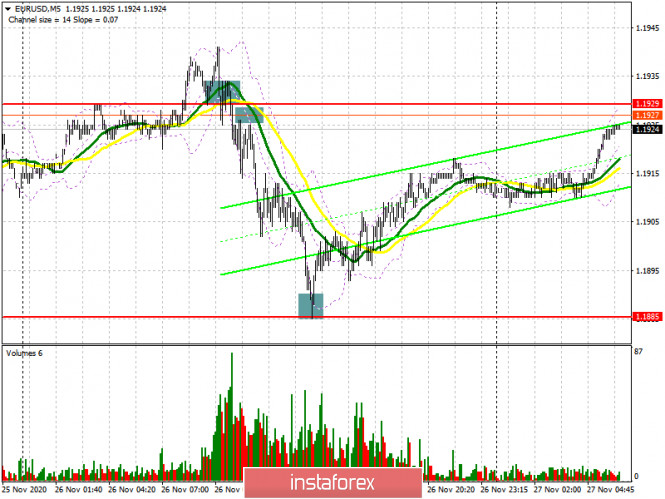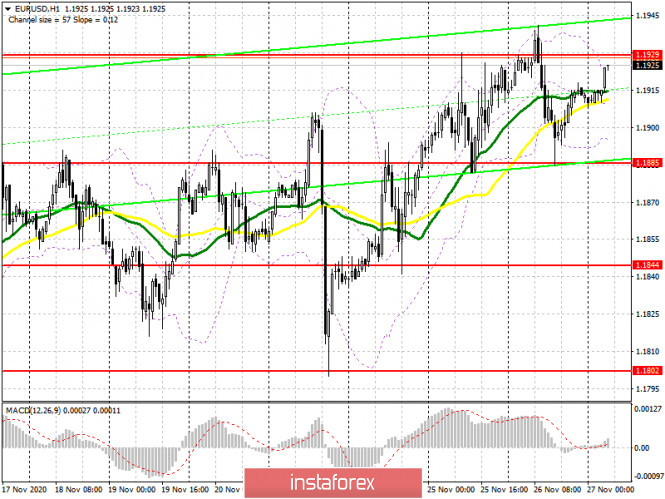
To open long positions on EUR/USD, you need:
In my morning forecast, I paid attention to buy positions from the 1.1929 level after a breakout and getting the pair to settle above this range, which happened. I marked an entry point for long deals after testing the 1.1929 level from top to bottom on the 5-minute chart. However, the bullish momentum failed to find support among major players, which ultimately led to a change in market sentiment. Returning and being able to settle below 1.1929 could have produced a good entry point for short positions, however, according to my trading strategy, this level was not tested upwards. If you read the afternoon forecast, then I was talking about the probability of buying in the support area of 1.1885. As you can see on the chart, testing this level led to a rapid upward reversal, which returned the pair to the 1.1929 resistance area during today's Asian session.

No important fundamental reports scheduled for release today, except for the report on the indicator of consumer confidence in the eurozone, which may turn out to be worse than economists' forecasts, which will put pressure on the euro. However, French GDP data will attract attention in the first half of the day, which is unlikely to affect the market. Good indicators will help the bulls in coping with their initial target, which is to break and settle at the 1.1929 high, testing it from top to bottom (similar to yesterday, which I analyzed above) provides a fairly convenient entry point into long positions in hopes for the euro to rise and reach a new level of 1.1964, where I recommend taking profits. The bulls will still aim for resistance of 1.2008, which is also psychological in nature. In case EUR/USD falls back to the 1.1885 area in the first half of the day, forming a false breakout there will be a signal to open long positions. If bulls are not active at this level, I recommend not to rush with long deals, but to wait for a downward correction to the support area of 1.1844, from where you can buy the euro immediately on a rebound, counting on an upward correction of 15-20 points. A larger support level is seen only at this week's low in the 1.1802 area, where you can also buy the euro immediately on the first test.
To open short positions on EUR/USD, you need:
The sellers' initial task is to return the 1.1885 level to themselves, where they have had huge problems for the second consecutive day. Even a negative report from the European Central Bank failed to influence buyers' sentiment at this level. Getting the pair to settle below 1.1885 and testing it from the bottom up provides a more convenient entry point for short positions, in hopes to bring back the downward trend. In this case, the nearest target will be the low of 1.1844, from which it was possible to observe the pair's active growth quite recently. However, updating this level will only be an indication that the trade is still in a horizontal channel. A breakout and being able to settle below this range will lead EUR/USD to the area of weekly lows at 1.1802, where I recommend taking profits. If the bulls turn out to be stronger and continue to push the pair after data on the French economy has been published, then it is best not to rush to sell, but to wait until a false breakout forms in the resistance area of 1.1929, which will be a signal to open short positions in the euro. I have analyzed an example of opening short positions from the 1.1929 level, see the 5-minute chart, where the entry point is shown after forming a false breakout and being able to return below the 1.1929 level. I recommend selling EUR/USD immediately on a rebound but only from a high of 1.1964, counting on a correction of 15-20 points within the day.

The COT report for November 17 showed an increase in long and short positions. Despite this, buyers of risky assets believe that the bull market will continue since the delta is on their side. Long non-commercial positions rose from 202,374 to 203,551, while short non-commercial positions increased from 67,087 to 69,591. The total non-commercial net position fell from 135,287 to 133,960 a week earlier. Take note that the delta has been declining for eight consecutive weeks, which confirms the euro buyers' reluctance to enter the market in the current conditions. We can talk about the euro's recovery only when European leaders have settled differences with Poland and Hungary, and also when the UK negotiates a new trade deal with Brussels. Otherwise, you will have to wait until restrictive measures have been lifted, which were implemented due to the second wave of coronavirus in many EU countries.
Indicator signals:
Moving averages
Trading is carried out just above 30 and 50 moving averages, which indicates the euro's succeeding growth in the short term.
Note: The period and prices of moving averages are considered by the author on the H1 hourly chart and differs from the general definition of the classic daily moving averages on the D1 daily chart.
Bollinger Bands
A breakout of the upper border of the indicator around 1.1930 will lead to a new wave of euro growth. In case the pair falls, support will be provided by the lower border at 1.1895.
Description of indicators
Moving average (moving average, determines the current trend by smoothing out volatility and noise). Period 50. It is marked in yellow on the chart.Moving average (moving average, determines the current trend by smoothing out volatility and noise). Period 30. It is marked in green on the chart.MACD indicator (Moving Average Convergence/Divergence — convergence/divergence of moving averages) Quick EMA period 12. Slow EMA period to 26. SMA period 9Bollinger Bands (Bollinger Bands). Period 20Non-commercial speculative traders, such as individual traders, hedge funds, and large institutions that use the futures market for speculative purposes and meet certain requirements.Long non-commercial positions represent the total long open position of non-commercial traders.Short non-commercial positions represent the total short open position of non-commercial traders.Total non-commercial net position is the difference between short and long positions of non-commercial traders.